NavSource Online: Aircraft Carrier Photo Archive
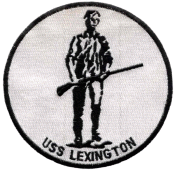
Courtesy of CAPT Gene Oleson, CHC, USN (Ret)

| Click on Thumbnail for Full Size Image |
Size | Image Description | Source | |
|---|---|---|---|---|
| World War II |
||||
 NS020253 |
39k | Fighting Squadron Three (VF-3), March 5, 1942. Standing, l to r: Mason, Clark, Sellstrom, Eder, Johnson, Lackey, Haynes, Stanley, Peterson, Dufilho, Lemmon. Sitting: Morgan, Vorse, Lovelace, Thach, Gayler, O'Hare, Rowell. Extreme left, back row: ENS Newton H. Mason was killed in action against Japanese forces in the Battle of the Coral Sea, May 1942. He was posthumously awarded the Distinguished Flying Cross for his skill and courage in battle. Destroyer escort USS Mason (DE-529) —the first Navy ship with a predominantly African-American crew— and guided missile destroyer USS Mason (DDG‑87) were named after him. Second from left, back row: LT(JG) Howard F. Clark won a Distinguished Flying Cross (DFC), February 20, 1942, when he brought down an enemy bomber attempting to attack USS Lexington. During the Battle of the Coral Sea, May 1942, he again and again engaged enemy aircraft, in utter disregard of his own safety, until his Wildcat was shot down. LT(JG) Clark was posthumously awarded a second DFC for his heroism during the battle, and destroyer escort USS Howard F. Clark (DE-533) was named after him. Third from left, back row: ENS Edward R. Sellstrom was awarded the Navy Cross for his "skillful marksmanship and courage" on February 20, 1942, when he intercepted an enemy four-engined bomber, determinedly pursued it through clouds and rain, and assisted in shooting it down despite heavy machine gun and cannon fire; later that day, he intercepted and shot down another aircraft during an attack directed at Lexington by nine enemy bombers. ENS Sellstrom was killed in an airplane crash, June 21, 1942, and destroyer escort USS Sellstrom (DE-255) was named after him. Fourth from left, back row: LT(JG) Willard E. Eder became a Navy ace, with 6–6.5 confirmed victories (sources differ), and earned the Navy Cross and other decorations. He retired as a Captain in July 1965. Third from right, back row:ENS Dale W. Peterson was awarded the Navy Cross for distinguished service in intercepting enemy bombers attacking Lexington, February 20, 1942. He was also awarded the Distinguished Flying Cross, posthumously, for his actions during the Battle of the Coral Sea, May 1942, in which he gave his life. Destroyer escort USS Dale W. Peterson (DE-337) was named after him. Second from right, back row: LT(JG) Marion W. Dufilho was posthumously awarded both the Navy Cross and the Distinguished Flying Cross for his heroism and achievement in the Battle of the Eastern Solomons, August 24, 1942, in which he gave his life. Destroyer escort USS Dufilho (DE-423) was named after him. Second from left, front row: LT Albert O. Vorse, Jr., became a Navy ace with 10.5–11.5 victories (sources differ). He earned the Navy Cross and other decorations and retired as a Rear Admiral in January 1959. Third from left, front row: LCDR Donald A. Lovelace won the Distinguished Flying Cross "for heroic conduct in aerial combat, as division leader and pilot, when on 20 February 1942, in enemy waters, he led his division in a vigorous and determined attack, in the face of combined machinegun and cannon fire, against a formation of enemy bombers, and he, with the assistance of his teammate, caused the destruction of one enemy bomber." LCDR Lovelace was killed in a plane crash shortly before the Battle of Midway, while searching for the Japanese naval force. Destroyer escort USS Lovelace (DE-198) was named after him. Center, front row: LCDR John S. "Jimmy" Thach, VF-3 Commanding Officer. He developed the fighter combat technique known as the "Thach Weave," that enabled the US Wildcat fighter to hold its own against the superior Japanese Zero. LCDR Thach led VF-3 from USS Lexington in early Pacific actions, and from USS Yorktown (CV-5) during the Battle of Midway (June 1942). He attained the rank of Admiral and retired in May 1967. John S. Thach earned two Navy Crosses, among many other decorations. Guided missile frigate USS Thach (FFG-43) was named after him. Third from right, front row:LT Noel A.M. Gayler was the first person to be awarded three Navy Crosses, and retired as an Admiral in September 1976. Second from right, front row: LT Edward H. "Butch" O'Hare, first Navy Ace in WW2 and Medal of Honor recipient: on February 20, 1942, he shot down five Japanese bombers and probably saved Lexington. Promoted to Lieutenant Commander, he was later Commander, Air Group Six aboard USS Enterprise (CV-6). He was reported as MIA in November 1943 and declared dead one year later. In addition to the Medal of Honor, he earned a Navy Cross and other awards. Destroyer USS O'Hare (DD-889) was named after him. Extreme right, front row:ENS Richard M. Rowell received the Distinguished Flying Cross for downing a Japanese plane, February 20, 1942, and won a second DFC during the Battle of the Coral Sea, May 1942, before failing to return from his last mission. Destroyer escort USS Richard M. Rowell (DE-403) was named after him. Additional notes: LT(JG) Howard L. Johnson was MIA, March 28, 1943. LT(JG) John H. Lackey, who earned a DFC, was killed on October 6, 1945. ENS Leon W. Haynes earned a Navy Cross and other decorations and retired as a Lieutenant Commander in October 1945. LT(JG) Onia B. Stanley, Jr., earned at least one DFC and retired as a Captain in July 1969. LT(JG) Rolla S. Lemmon earned a Navy Cross and was MIA, June 24, 1944. LT(JG) Robert J. Morgan earned a Navy Cross and other decorations and retired as a Captain in July 1968. |
Hugh Stratford, VF-3, 1941-1942 | |
 NS020297 |
70k | The four 8-in mounts were removed from Lexington at Pearl Harbor on 30 March 1942, and made available to the Hawaiian Department, U.S. Army, four days later. It was planned to replace the 8-inch/55 batteries with 5-inch/38 dual-purpose twin mounts, but Lexington was sunk on 8 May 1942, during the Battle of the Coral Sea, before the 5-in mounts were installed. |
Ron Reeves | |
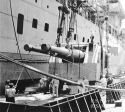 NS020297a |
275k | Ron Reeves and Robert Hurst | ||
 NS020297b |
161k | |||
 NS020297c |
47k | Ron Reeves | ||
 NS020297d |
70k | |||
 NS020254 |
1.21M | Grumman F4F-3 Wildcat fighters, of Fighting Squadron Three (VF-3) in flight near Naval Air Station, Kaneohe, Oahu, Hawaii, 10 April 1942. The planes are Bureau # 3976 (F-1, foreground), flown by VF-3 Commanding Officer Lieutenant Commander John S. Thach, and Bureau # 3986 (F-13), flown by Lieutenant Edward H. O'Hare. Photographed by Photographer Second Class H.S. Fawcett. Official U.S. Navy Photograph, now in the collections of the National Archives and Records Administration (NARA), # 80-G-10613. On February 20, 1942, F-1, flown by Thach and LT Noel Gayler, shot down a bomber and assisted in downing two more bombers and a patrol plane. F-13, flown by Thach and ENS Leon Haynes, shot down a bomber and assisted in downing another bomber and a patrol plane. Both of these aircraft were lost a little less than a month later with USS Lexington (CV-2), during the Battle of Coral Sea. |
Bob Canchola, BT, USN (Ret.) | |
 NS020254a |
265k | As above. Note VF-3's "Felix the Cat" insignia painted under the windshields of both aircraft. Thach's Wildcat has three Japanese "kill" markings under the cockpit, representing three Japanese aircraft he had shot down up to that point. O'Hare's F4F-3 has five markings, signifying the five bombers he shot down on 20 February 1942. |
||
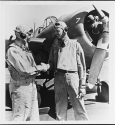 NS020254b |
278k | Lieutenant Edward H. (Butch) O'Hare, USN, (left) and Lieutenant Commander John S. Thach, USN, shaking hands in front of a Grumman F4F Wildcat fighter plane at an Oahu air base, circa April–May 1942. Both men were assigned to Fighting Squadron (VF) 3, of which Thach was Commanding Officer. Official U.S. Navy Photograph, now in the collections of the U.S. National Archives and Records Administration (NARA), Catalog #: 80-G-457493. |
||
| Battle of the Coral Sea, May 1942 |
||||
 NS020225a |
1.17M | Deck Logs, USS Lexington (CV-2), 8 May 1942 (the day she was sunk). |
National Archives | |
 NS0202ah |
75k | USS Lexington (CV-2) in the early part of the Battle of the Coral Sea (4–8 May 1942) in the SW Pacific; a mighty ship with a sad ending. The photo is from the "Ralph Goodwin Collection" held by Museum Victoria and is in the public domain. Ralph Goodwin was an Able Seaman on HMAS Hobart (D63) which took part in the Coral Sea Battle, May 1942. This picture is included in his photo album with the note "USS Lexington (sank later)." |
Kimberley Dunstan | |
 NS0202am |
518k | Paintings of Naval Aviation during World War II: Abbott Collection. #99: "Death of Shoho." Artwork by Robert Benney. "In May 1942, the U.S. Navy participated in the Battle of the Coral Sea, in which the might of Naval Aviation shattered and turned back the spearhead of a Japanese battle force. Here, aflame from stem to quarter, the Japanese aircraft carrier Shoho falls victim to the lethal combat tactics of U.S. Navy dive and torpedo bombers. The Shoho plowed herself under within a period of minutes after dive and torpedo squadrons broke her back." National Museum of the US Navy (NMUSN), photo # Lot 3124-15. |
NMUSN | |
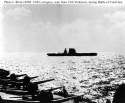 NS020225 |
119k | USS Lexington (CV-2) during the action, seen from USS Yorktown (CV-5), 8 May 1942. Large number of planes on deck and low sun indicate that the photo was taken early in the morning, prior to launching the strike against the Japanese carrier force. Yorktown has several SBDs and F4Fs on deck with engines running, apparently preparing to take off. Lexington, whose silhouette has been altered by the earlier removal of her 8-inch gun mounts, has planes parked fore and aft, and may be respotting her deck in preparation for launching aircraft. Official U.S. Navy Photograph, now in the collections of the National Archives. (# 80-G-16569). |
NHC | |
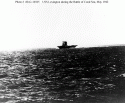 NS020226 |
88k | USS Lexington (CV-2) underway, as seen from USS Yorktown (CV-5), probably during the early morning of 8 May 1942. Official U.S. Navy Photograph, now in the collections of the National Archives. (# 80-G-16565). |
NHC | |
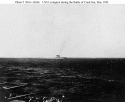 NS020227 |
70k | USS Lexington (CV-2) underway, probably during the early morning of 8 May 1942. Photographed from USS Yorktown (CV-5). Official U.S. Navy Photograph, now in the collections of the National Archives. (# 80-G-16566). |
NHC | |
 NS020228 |
84k | USS Lexington (CV-2) under air attack on 8 May 1942, as photographed from a Japanese plane. Heavy black smoke from her stack and white smoke from her bow indicate that the view was taken just after those areas were hit by bombs. Destroyer in the lower left appears to be USS Phelps (DD-360). The original print was from the illustration files for Rear Admiral Samuel Eliot Morison's "History of U.S. Naval Operations in World War II". U.S. Naval Historical Center Photograph (# NH 95579). |
NHC | |
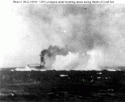 NS020229 |
62k | USS Lexington (CV-2) under Japanese dive bomber attack, shortly before Noon on 8 May 1942, during the Battle of the Coral Sea. Official U.S. Navy Photograph, now in the collections of the National Archives. (# 80-G-19100). |
NHC | |
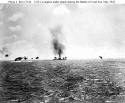 NS020224 |
137k | USS Lexington hit and burning, during the later part of the Japanese air attack on 8 May. Note anti-aircraft bursts in the vicinity, and a plane off the ship's bow. Official U.S. Navy Photograph, now in the collections of the National Archives. (# 80-G-7414). |
NHC | |
 NS020230 |
92k | USS Lexington (CV-2) afire and down at the bow, but still steaming and operating aircraft, shortly after she was hit by Japanese torpedoes and bombs during the Battle of the Coral Sea. This view was taken about Noon on 8 May 1942, before fires were extinguished from a bomb hit on the carrier's smokestack. Plane overhead is a Grumman F4F Wildcat fighter. Official U.S. Navy Photograph, now in the collections of the National Archives. (# 80-G-16643). |
NHC | |
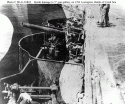 NS020232 |
117k | Damage in the port forward 5-inch gun gallery of USS Lexington (CV-2), from a Japanese bomb that hit near the gallery's after end during the Battle of the Coral Sea, 8 May 1942. The ship's # four 5"/25 gun is in the left center of the view, which looks forward. Staining on the photographic image is possibly due to water damage received when the photographer abandoned ship. Official U.S. Navy Photograph, now in the collections of the National Archives. (# 80-G-16803). |
NHC | |
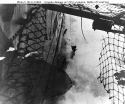 NS020235 |
101k | View on the port side of USS Lexington (CV-2), looking aft and down through torn flight deck life nettings, showing damage from the aftermost of the two torpedo hits received during the Battle of the Coral Sea, 8 May 1942. This hit was centered at about Frame 85, and blew some of the ship's hull blister plating up and out, as seen at the waterline in this photo. Official U.S. Navy Photograph, now in the collections of the National Archives (# 80-G-16804). |
NHC | |
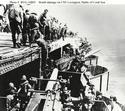 NS020220h |
377k | Damage in the port forward 5-inch gun gallery on USS Lexington (CV-2), from a Japanese bomb that struck near the gallery's after end during the Battle of the Coral Sea, 8 May 1942. View looks aft, with the ship's number two 5"/25 gun in the foreground, still manned and in operation. Number four 5"/25 gun is immediately beyond, trained out to port and aft. Official U.S. Navy Photograph, now in the collections of the National Archives (# 80-G-16805). |
Courtesy of Scott Koen & ussnewyork.com | |
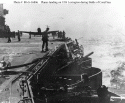 NS020234 |
90k | Planes returning on board USS Lexington (CV-2) at about 1400 hrs. on 8 May 1942, during the Battle of the Coral Sea. View looks aft along the port side of the flight deck from the front of the bomb-damaged port forward 5-inch gun gallery. Number two 5"/25 gun is in the foreground, trained out and still in operation. The damaged number four and number six 5"/25 guns are immediately beyond. A TBD-1 torpedo plane is on the flight deck, taxiing forward after landing, and a F4F-3 fighter is approaching to land. Official U.S. Navy Photograph, now in the collections of the National Archives (# 80-G-16806). |
NHC | |
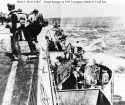 NS020233 |
138k | Damage in the port forward 5-inch gun gallery on USS Lexington (CV-2), from a Japanese bomb that struck near the gallery's after end during the Battle of the Coral Sea, 8 May 1942. View looks aft, with the damaged number four 5"/25 gun in the foreground, trained to port and aft. Official U.S. Navy Photograph, now in the collections of the National Archives. (# 80-G-16807). |
NHC | |
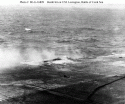 NS020231 |
94k | Flight deck damage on USS Lexington (CV-2), from a Japanese bomb that hit near the after end of the port forward 5-inch gun gallery, during the Battle of the Coral Sea, 8 May 1942. This hit was evaluated as being from a relatively small bomb, instantaneously fuzed. Photographed from the carrier's island, with the flight deck palisade at right, and the port forward corner of the forward aircraft elevator in the lower left. Official U.S. Navy Photograph, now in the collections of the National Archives. (# 80-G-16809). |
NHC | |
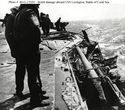 NS020220i |
345k | Repair crew at work on USS Lexington (CV-2), soon after she was hit by Japanese dive bombing attack on 8 May 1942, during the Battle of the Coral Sea. View looks aft along the port side of the flight deck from alongside number six 5"/25 gun, which was put out of action by a bomb hit nearby. Flight deck damage visible in the center of this view was caused by that bomb. Official U.S. Navy Photograph, now in the collections of the National Archives (# 80-G-17039). |
Courtesy of Scott Koen & ussnewyork.com | |
 NS020202 |
56k | USS Lexington (CV-2) underway during the Battle of Coral Sea, 8 May 1942. This view appears to have been taken in the early afternoon, about 1430, after planes of VT-2 and escort had been recovered and initial damage control measures effected, but before the start of the fires that led to the ship's loss. This is the last known photograph of Lexington in operational condition [note she is already down by the bow after being torpedoed]. Taken from USS Portland (CA-33). Courtesy of the Naval Historical Foundation, Washington, D.C., 1972. Collection of Captain Benjamin Perlman. U.S. Naval Historical Center Photograph (# NH 76560). |
NHC | |
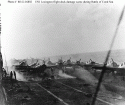 NS020236 |
82k | View on the flight deck of USS Lexington (CV-2), at about 1500 hrs. on 8 May 1942, during the Battle of the Coral Sea. The ship's air group is spotted aft, with Grumman F4F-3 fighters nearest the camera. SBD scout bombers and TBD-1 torpedo planes are parked further aft. Smoke is rising around the after aircraft elevator from fires burning in the hangar. Note fire hose, wheels, propellers, servicing stands and other gear scattered on the flight deck. Official U.S. Navy Photograph, now in the collections of the National Archives (# 80-G-16802). |
NHC | |
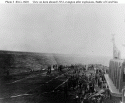 NS020237 |
71k | View on the flight deck of USS Lexington (CV-2), at about 1700 hrs. on 8 May 1942, as the crew prepares to abandon ship, after the series of explosions that produced uncontrollable fires and brought her to a stop. Photographed from the ship's island, looking forward, with fire hoses and debris (including an aircraft landing gear wheel) visible on the flight deck. USS Minneapolis (CA-36) is faintly visible in the center, crossing Lexington's bow. Official U.S. Navy Photograph, now in the collections of the National Archives (# 80-G-16811). |
NHC | |
 NS020221 |
611k | A destroyer alongside USS Lexington (CV-2) as the carrier is abandoned during the afternoon of 8 May 1942. Note crewmen sliding down lines on Lexington's starboard quarter. Official U.S. Navy Photograph, now in the collections of the National Archives and Records Administration (NARA), # 80-G-7398. |
NARA, via Bob Canchola, BT, USN (Ret.) |
|
 NS020221a |
122k | As above. |
Tonnya Borghill (Denmark) | |
 NS020221b |
84k | Crewmen abandoning USS Lexington (CV-2) on 8 May 1942 during the Battle of the Coral Sea. A destroyer and ship's boat are on station to pick up survivors. US Navy and Marine Corps Museum/Naval Aviation Museum, photo No.2001.205.068. |
Mike Green | |
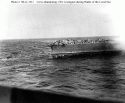 NS020223 |
101k | Crewmen sliding down lines at the stern of USS Lexington (CV-2), as the carrier is abandoned during the afternoon of 8 May 1942. A whaleboat is standing by off the ship's starboard quarter and a motor launch is astern. Note TBD, SBD and F4F aircraft spotted on the flight deck. Identification markings on the torpedo planes and fighters appear to be white, while those on the SBDs appear to be black. Official U.S. Navy Photograph, now in the collections of the National Archives. (# 80-G-7411). |
NHC | |
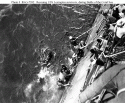 NS020220 |
130k | Survivors of USS Lexington (CV-2) are pulled aboard a cruiser (probably USS Minneapolis) after the carrier was abandoned during the afternoon of 8 May 1942. Note man in the lower part of the photo who is using the cruiser's armor belt as a hand hold. Official U.S. Navy Photograph, now in the collections of the National Archives (# 80-G-7392). |
NHC | |
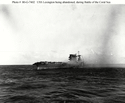 NS020220a |
274k | USS Lexington (CV-2) is abandoned, after she had been mortally damaged by fires and explosions during the afternoon of 8 May 1942. A destroyer is alongside her starboard side, amidships, to assist in removing the carrier's crew. Official U.S. Navy Photograph, now in the collections of the National Archives (# 80-G-7402). |
Courtesy of Scott Koen & ussnewyork.com | |
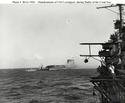 NS020220b |
325k | Destroyers alongside USS Lexington (CV-2) to assist in the carrier's abandonment, after she had been mortally damaged by fires and explosions during the afternoon of 8 May 1942. Photographed from a cruiser, probably USS Minneapolis (CA-36). Note SOC scouting plane, with a damaged wingtip, on the cruiser's port catapult. Official U.S. Navy Photograph, now in the collections of the National Archives (# 80-G-7403). |
Courtesy of Scott Koen & ussnewyork.com | |
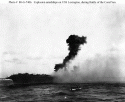 NS020222 |
73k | An explosion amidships on USS Lexington (CV-2), while she was being abandoned during the afternoon of 8 May 1942. This may be the explosion reported to have taken place at 1727 hrs, which was followed by a "great explosion" aft as stowed torpedo warheads detonated on the hangar deck. Note whaleboat underway in the foreground. Official U.S. Navy Photograph, now in the collections of the National Archives (# 80-G-7406). |
NHC | |
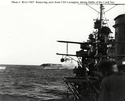 NS020220c |
304k | USS Lexington (CV-2) is abandoned, during the afternoon of 8 May 1942. One destroyer is alongside her starboard side, and another is standing off her stern. Photographed from a cruiser, probably USS Minneapolis (CA-36). Note SOC scouting plane, with a damaged wingtip, on the cruiser's port catapult. Official U.S. Navy Photograph, now in the collections of the National Archives (# 80-G-7407). |
Courtesy of Scott Koen & ussnewyork.com | |
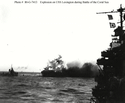 NS020220d |
246k | A heavy explosion on board USS Lexington (CV-2) blows an aircraft over her side, 8 May 1942. This is probably the great explosion from the detonation of torpedo warheads stowed in the starboard side of the hangar, aft, that followed an explosion amidships at 1727 hrs. At left is USS Hammann (DD-412), which was backing away with a load of the carrier's survivors on board. Photographed from USS Minneapolis (CA-36). Official U.S. Navy Photograph, now in the collections of the National Archives (# 80-G-7413). |
Courtesy of Scott Koen & ussnewyork.com | |
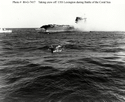 NS020220e |
347k | USS Lexington (CV-2) burning during the afternoon of 8 May 1942, at the time she was abandoned. Several destroyers are standing by to assist in removing the carrier's crew and a whaleboat full of men is in the center of the view, headed toward the camera. Official U.S. Navy Photograph, now in the collections of the National Archives (# 80-G-7417). |
Courtesy of Scott Koen & ussnewyork.com | |
 NS020220f |
306k | Destroyers assist with the abandonment of USS Lexington (CV-2), during the afternoon of 8 May 1942. See photo NS020220b for a virtually identical view, cropped less tightly. Official U.S. Navy Photograph, now in the collections of the National Archives (# 80-G-11915). |
Courtesy of Scott Koen & ussnewyork.com | |
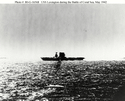 NS020220g |
360k | USS Lexington (CV-2) with planes spotted fore and aft, photographed from USS Yorktown (CV-5). Probably taken during the early morning of 8 May, before planes were launched to attack the Japanese carriers. Official U.S. Navy Photograph, now in the collections of the National Archives (# 80-G-16568). |
Courtesy of Scott Koen & ussnewyork.com | |
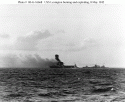 NS020238 |
83k | Explosion amidships on USS Lexington (CV-2), 8 May 1942. This is probably the explosion at 1727 hrs that took place as the carrier's abandonment was nearing its end. Ships standing by include the cruiser Minneapolis (CA-36) and destroyers Morris (DD-417), Anderson (DD-411) and Hammann (DD-412). Official U.S. Navy Photograph, now in the collections of the National Archives (# 80-G-16668). |
NHC | |
 NS020239 |
101k | Explosion amidships on USS Lexington (CV-2), 8 May 1942. This is probably the explosion at 1727 hrs that took place as the carrier's abandonment was nearing its end. Ships standing by include two cruisers and several destroyers. Photographed from USS Portland (CA-33). Courtesy of the Naval Historical Foundation, Washington, D.C., 1972. Collection of Captain Benjamin Perlman. U.S. Naval Historical Center Photograph (# NH 76561). |
NHC | |
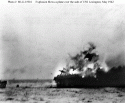 NS020240 |
69k | A heavy explosion on board USS Lexington (CV-2) blows an aircraft over her side, 8 May 1942. This is probably the "great explosion" from the detonation of torpedo warheads stowed in the starboard side of the hangar, aft, that took place just after the ship's Commanding Officer, Captain Frederick C. Sherman, left Lexington. At left is the bow of USS Hammann (DD-412), which was backing away with a load of the carrier's survivors on board. Official U.S. Navy Photograph, now in the collections of the National Archives (# 80-G-11916). |
NHC | |
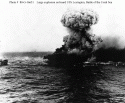 NS020241 |
93k | A "mushroom cloud" rises after a heavy explosion on board USS Lexington (CV-2), 8 May 1942. This is probably the "great explosion" from the detonation of torpedo warheads stowed in the starboard side of the hangar, aft, that followed an explosion amidships at 1727 hrs. Note USS Yorktown (CV-5) on the horizon in the left center, and destroyer USS Hammann (DD-412) at the extreme left. Official U.S. Navy Photograph, now in the collections of the National Archives (# 80-G-16651). |
NHC | |
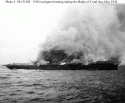 NS020214 |
84k | USS Lexington (CV-2) burning and sinking after her crew abandoned ship during the Battle of Coral Sea, 8 May 1942. Note planes parked aft, where fires have not yet reached. U.S. Naval Historical Center Photograph. (# NH 51382). |
NHC | |
 NS020271 |
238k | Commendation from the Commander-in-Chief, U.S. Pacific Fleet, to the officers and men of the Lexington and her air group. |
Charles F. Hansen, son of Harold F. Hansen, QM2c, U.S. Navy | |
 NS0202br |
2.46M | Rear Admiral Sherman's Farewell Address to the Officers and Men of the Lexington. (Transcription, by Tad Rockwell). "My Dad, Julius Rockwell Jr, was a CV-2 Survivor from WW2 (the battle of the Coral Sea). He passed in 2015 [...] I was going though some of [his] items and found this. [...] [I]t looks like my dad kept it with him for many years from the look of it." |
Julius Rockwell IV (Tad) | |
 NS020283 |
50k | Lieutenant Commander William E. Hall, USNR, photographed circa 1944–1945. Lieutenant (Junior Grade) William E. Hall was awarded the Medal of Honor for "extreme courage and conspicuous heroism" while serving as a Pilot of a Scouting Plane in action against Japanese forces in the Battle of the Coral Sea, 7 and 8 May 1942. Contributing to the destruction of the Japanese aircraft carrier Shoho on 7 May, he waged counterattacks the next day on a superior number of enemy planes, shooting down three enemy aircraft. Although Hall was seriously wounded during this mission, he remained in flight and safely landed his plane. He was then serving with Scouting Squadron TWO, based on board USS Lexington (CV-2). Official U.S. Navy photograph from the collections of the Naval History & Heritage Command (# NH 106210-A). |
Bill Gonyo | |
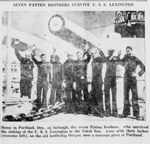 NS010357 |
N/A | "SEVEN PATTEN BROTHERS SURVIVE U.S.S. LEXINGTON" "Home in Portland, Ore., on furlough, the seven Patten brothers, who survived the sinking of the U.S.S. Lexington in the Coral Sea, were with their father (extreme left), on the old battleship Oregon, now a museum piece at Portland." |
Image and text provided by Alaska
State Library Historical Collections. Photo from The
Nome Nugget. [volume] (Nome, Alaska) 1938–????, 20 July 1942, Image 1, courtesy of
chroniclingamerica.loc.gov, via Michael Mohl |
|
 NS020293 |
214k | Three Japanese propaganda postcards of the sinking of USS Lexington (CV-2). NS020293 reads, in Japanese: "Battle of the Coral Sea," "Artwork by Kenichi Nakamura," "Authorized by the Ministry of Navy." NS020293a & NS020293aa: Same postcard, different text. |
Arnold Putnam | |
 NS020293a |
219k | |||
 NS020293aa |
127k | Tommy Trampp | ||
 NS020293b |
229k | Arnold Putnam | ||
| Memorabilia |
||||
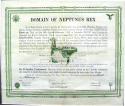 NS020255 |
363k | Shellback Certificate for Hugh N. Stratford, February 1942, signed by Captain Frederick C. Sherman. |
Hugh Stratford, VF-3, 1941-1942 | |
 NS020272 |
811k | "A Salute to the U.S.S. Lexington", 'Queen of the Flat Tops'," a collection of poems written as tributes to the ship, its officers and men, published privately by Rear Admiral Frederick C. Sherman, U.S. Navy. (Get FREE Adobe Reader.) |
Charles F. Hansen, son of Harold F. Hansen, QM2c, U.S. Navy | |
|
||||
| Main Photo Index |
Aircraft Carrier Photo Index Page |
Comments, Suggestions or Image submissions, E-mail Carrier Information
Problems and site related matters, E-mail Webmaster
This page was created and is maintained by Fabio Peña
![]()
Last update: 31 March 2025